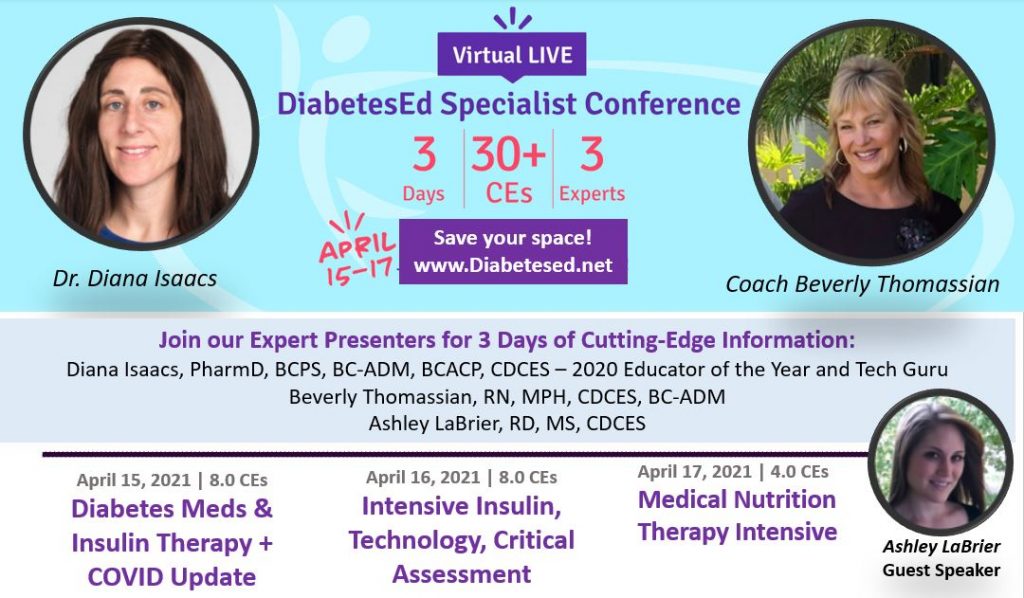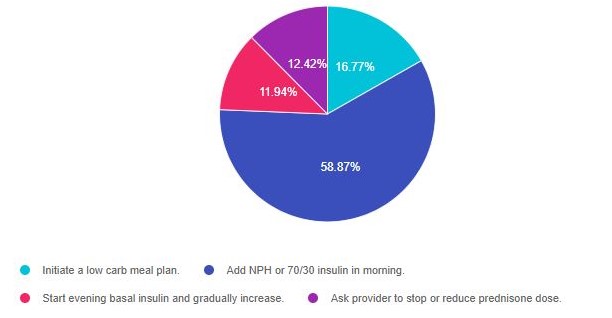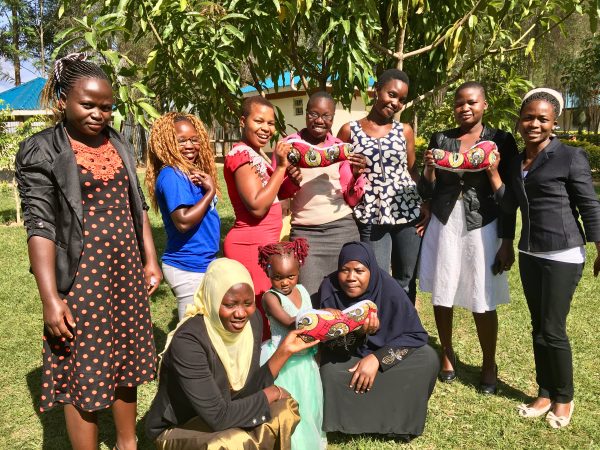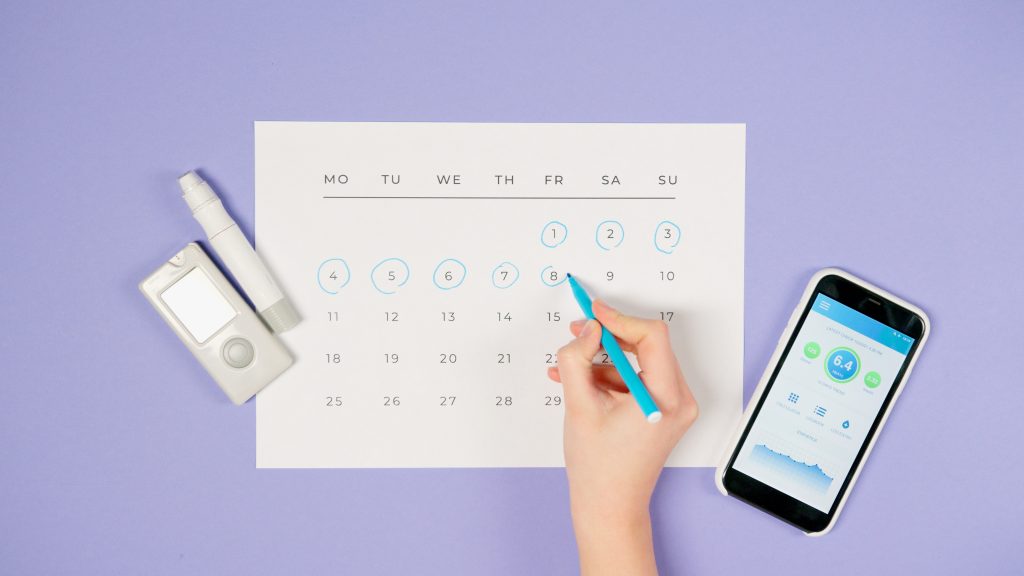Interview with Dr. Diana Isaacs | Keynote for DiabetesEd Virtual Conference
Diana Isaacs, PharmD, BCPS, BC-ADM, BCACP, CDCES

We are thrilled that Diana Isaacs will be joining our Virtual Course on October 6-8, 2021!
Dr. Isaacs was named 2020 ADCES Diabetes Educator of the Year for her educational platform promoting the use of technology, pumps, and CGM therapy for people with diabetes plus other innovations. Dr. Isaacs was awarded the Ohio Pharmacists Association Under 40 Award in 2019. Dr. Isaacs has served in leadership roles for several pharmacies and diabetes organizations. She has numerous diabetes publications and research projects with a focus on medications, CGM and diabetes technology.
As the CGM Program Coordinator and clinical pharmacist specialist in the Cleveland Clinic Diabetes Center, Dr. Isaacs brings a wealth of clinical knowledge combined with extensive research experience to this program.
Exclusive Interview with Dr. Diana Isaacs
Question: What do you love about being a Diabetes Specialist?
Dr. Isaacs: I have the opportunity to help people manage their diabetes through my expertise and support. I start many people with diabetes on CGM and I see first hand how life changing the technology is for them. People are very grateful for my help and it is so rewarding.
Question: Over the past year, what has been most challenging about providing diabetes care during the pandemic?
Dr. Isaacs: I miss doing the group classes and shared medical appointments but we’ve had to majorly scale back taking into consideration room size and safety. Also, many people are struggling with mental health during the pandemic and many are afraid to come to clinic. However, we have made great strides by increasing access through virtual care.
Question: What role do you see technology playing in people with diabetes lives over the next few years?
Dr. Isaacs: Technology is exploding. Virtual care is allowing us to reach way more people with diabetes and making it more convenient for everyone. Mobile apps and blue tooth technology are making it so the healthcare team can access a person’s diabetes data from anywhere (With their permission of course). There also continue to be huge improvements in insulin pump, continuous glucose meter, and smart insulin pen technology.
Question: What actions can Diabetes Specialists take to increase access to diabetes technologies including insulin pumps, CGMs and Smart Pens.
Dr. Isaacs: We need to stay up to date on all of the technology because it’s evolving so quickly. Some strategies to do this include attending professional meetings, meet with your sales reps, check out websites like diabeteswise.org and DANAtech (offered through ADCES). There are many continuing education opportunities offered through various organizations, including your website (www.diabetesed.net).
Also, if you get a chance to try a demo (Such as obtaining a sample of a smart pen, or CGM) and wearing it. That’s the best way to learn!. There are also various demo mobile apps that give the user experience. (Ex. T:Simulator for Tandem insulin pumps).
Question: Would you share your hobby (ies) and how you maintain work life balance?
Dr. Isaacs: I have 5 kids ages 2-9, so they keep me pretty busy. One day a week I completely disconnect from all electronics and just spend time with the family. I also enjoy running and run almost every morning before starting my day. With the pandemic I stopped going to the gym. I live in Cleveland and am proud to say I ran outside even when it was 3 degrees with lots of snow and ice on the ground.
Accreditation: Diabetes Education Services is an approved provider by the California Board of Registered Nursing, Provider 12640, and Commission on Dietetic Registration (CDR), Provider DI002. Since these programs are approved by the CDR it satisfies the CE requirements for the CDCES regardless of your profession.*
The use of DES products does not guarantee the successful passage of the CDCES exam. CBDCE does not endorse any preparatory or review materials for the CDCES exam, except for those published by CBDCE.
March eNews | Steroids, Sugar Spikes and Nutrition Month Celebration
March | Steroids, Sugar Spikes and Nutrition Month Celebration

March is National Nutrition Month
This gives us a whole month to celebrate the amazing expertise and abundant knowledge of our nutrition colleagues.
We will be focusing on nutrition dilemmas for our Question of the Week and featuring spring recipes along with plant-based resources.
Plus, we are excited to highlight Ashley LaBrier, MS, RD, CDCES, our new dietitian team member and Virtual Conference speaker. Welcome to the team Ashley!
For our feature article, we recognize that many people with diabetes and COVID started on steroids are experiencing hyperglycemic crisis. Coach Beverly summarizes strategies to get glucose to target during steroid therapy.
We are also excited to feature an interview with Diana Isaacs, PharmD, BCPS, BC-ADM, BCACP, CDCES.
We are thrilled that Diana is providing 8 hours of content for our Virtual Conference in April. She is a pharmacology and technology expert, with a special knack for translating the complex world of diabetes technologies into understandable terms. Read more about this ADCES Educator of the Year in our interview below.
Lastly, we have expanded our FREE Webinar offerings. Coach Beverly explores the different diabetes certification options and provides test-taking skill-building. We hope you can join us!
Happy Nutrition Month everyone.
We wish you all health and an abundance of fiber intake from a variety of whole grains and fresh foods!
With affection and wishes for health,
Coach Beverly, Bryanna, and Jackson
Click here to read our full March 2021 newsletter.
Featured Blogs
- Steroids, Sugar Spikes, & Management Strategies
- Interview with Dr. Isaacs – Keynote for Virtual Conference
- Interview with Ashley LaBrier – Nutrition Expert for Virtual Conference
- Rationale of the Week
Featured Items
- FREE Webinars Ready for Viewing
- Virtual DiabetesEd Specialist Conference – from April 15th – 17th
- ADCES Exam Prep Book Bundle
- Free Resources Catalog
Virtual DiabetesEd Specialist Course
Earn 30+ CEs | April 15-17, 2021

Virtual DiabetesEd Specialist Program
Whether you are new to diabetes or a seasoned expert, you’ll benefit from this virtual conference with the latest research plus critical content that you can immediately apply to your clinical practice.
DiabetesEd Virtual Conference Flyer 2021
Diabetes Ed Virtual 3-Day Schedule 2021
Prepare for CDCES or BC-ADM certification or earn hours for renewal.
If you are interested in taking the CDCES or BC-ADM exam or are seeking a state of the art review of current diabetes care, this course is for you. Our team has been fine-tuning this course for over fifteen years, and we know what you need.
Can’t join live? No worries, your registration guarantees access to the recorded content through Dec 31, 2021!
Team of expert faculty includes:
- Diana Isaacs, PharmD, BCPS, BC-ADM, BCACP, CDCES – Educator of the Year, 2020
- Coach Beverly Thomassian, RN, MPH, CDCES, BC-ADM
- Ashley LaBrier, MS, RD, CDCES, Diabetes Program Coordinator
In addition to informative lectures, we also use group activities and case studies to highlight the essential knowledge, skills, and strategies needed to succeed in diabetes education today!
Your registrations include access to all the Online Sessions plus Bonus Courses through December 31st, 2021.
Bonus Courses worth 14 + CEs FREE – When you register for our Virtual Course, you have immediate access to these Bonus DiabetesEd University Online Courses – for FREE!
ADCES Desk Reference + 5th Ed Review Guide Book Bundle
The 5th Edition ADCES Desk Reference & 5th Edition Review Guide Bundle –our most popular AADE Book Bundle for exam preparation!
What is included in the ADCES Book Bundle?
The Art & Science of Diabetes Self-Management Education Desk Reference – 5th Edition
Major Features:
- practical information educators can use with patients to avoid complications and comorbidities
- risks and benefits of CGM and the educator’s role in working with patients who use CGM
- updated info on incorporating the ADA, AADE, and AND joint position statement and algorithm of care into a DSME program
ADECES Review Guide for the Diabetes Care and Education Specialist Exam – 5th Edition
Includes an answer key with rationales for all questions included in the guide!
Major Features:
- 480 + multiple-choice questions
- Strategies for preparing for and taking the exam
3 self-assessment tests that cover three main content sections on the CDCES Exam:
- Assessment of Diabetes and Prediabetes
- Interventions for Diabetes and Prediabetes
- Disease Management
Sign up for Diabetes Blog Bytes – we post one daily Blog Byte from Monday to Friday. And of course, Tuesday is our Question of the Week. It’s Informative and FREE! Sign up below!
[yikes-mailchimp form=”1″]
Accreditation: Diabetes Education Services is an approved provider by the California Board of Registered Nursing, Provider 12640, and Commission on Dietetic Registration (CDR), Provider DI002. Since these programs are approved by the CDR it satisfies the CE requirements for the CDCES regardless of your profession.*
The use of DES products does not guarantee the successful passage of the CDCES exam. CBDCE does not endorse any preparatory or review materials for the CDCES exam, except for those published by CBDCE.
Rationale of the Week | Steroids, Sugar Spikes and Management Strategies

For our March 2nd Question of the Week, over 58% of respondents chose the best answer!
Before we start though, if you don’t want any spoilers and haven’t tried the question yet, you can answer below: Answer Question
Question: JR is 53 yrs old with type 2 diabetes, BMI of 24.3 and is recovering from a COVID infection. In addition to metformin, a SGLT-2i and a weekly GLP-1 RA, JR is on daily prednisone. Morning blood glucose levels are in the low 100’s, lunch and dinner blood glucose levels are in the 250-300 range.
Which of the following is the best treatment intervention to get lunch and dinner blood glucose levels to goal?
Answer Choices:
- Initiate a low carb meal plan
- Add NPH or 70/30 insulin in morning
- Start evening basal insulin and gradually increase
- Ask provider to stop or reduce prednisone dose

As shown above, the most common choice was option 2, the second most common answer was option 1, then option 4, and finally option 3.
Getting to the Best Answer
If you are thinking about taking the certification exam, the content of this practice test question will set you up for success. The exam often presents vignettes that compel test takers to determine which option offers the BEST answer based on the action times of different insulins.
Answers & Rationale
Answer 1 is incorrect, 16.77% chose this answer. “Initiate a low carb meal plan “. JR has a BMI that is less than 25, which indicates a healthy weight. In addition, JR is recovering from COVID, so making sure they are eating adequate calories and healthy carbs during this recovery phase is very important. Lastly, the spike in blood glucose between lunch and dinner is an expected response since JR is taking morning prednisone.
AM steroids cause hyperglycemia through lunch and dinner.
Answer 2 is correct, 58.87% of you chose this answer. “Add NPH or 70/30 insulin in morning”. YES! Since morning steroids increase insulin resistance throughout the day, especially around lunch and dinner time, morning NPH insulin works remarkably well. This is because NPH action time peaks within 4-10 hours of injection. Another option is to use 70/30 insulin, which is a combination of 70% NPH (or basal) insulin plus 30% bolus. This insulin used before the first meal of the day, can help prevent lunch and dinner blood sugars from going above target later in the day.
Dosing for NPH or 70/30 depends on several factors, including steroid dose, diabetes type and history, body weight and health status. See our article on Steroids and Sugar Spikes – Management Strategies
Answer 3 is incorrect, 11.94% of you chose this answer “Start evening basal insulin and gradually increase”. When people are on morning steroids, their overnight blood sugars generally trend down. Basal insulin isn’t the best choice for addressing mid day to evening glucose elevations.
Answer 4 is incorrect, 12.42% of you chose this answer. “Ask provider to stop or reduce prednisone dose”. While it is true that stopping the prednisone will improve blood glucose levels, it could also contribute to a worsening health status. One of the most effective treatments for people with a serious COVID infection is steroid therapy to decrease inflammation, especially in the lungs. We approach this situation understanding that the steroid is essential and we can help with glucose management to promote recovery.
Want to learn more about this topic? Join Coach Beverly during the Virtual Conference, where she will be discussing treatment strategies for hyperglycemia secondary to steroids.
We hope you appreciate this week’s rationale! Thank you so much for taking the time to answer our Question of the Week and participate in this fun learning activity!
ADCES Desk Reference + 5th Ed Review Guide Book Bundle
The 5th Edition ADCES Desk Reference & 5th Edition Review Guide Bundle –our most popular AADE Book Bundle for exam preparation!
What is included in the ADCES Book Bundle?
The Art & Science of Diabetes Self-Management Education Desk Reference – 5th Edition
Major Features:
- practical information educators can use with patients to avoid complications and comorbidities
- risks and benefits of CGM and the educator’s role in working with patients who use CGM
- updated info on incorporating the ADA, AADE, and AND joint position statement and algorithm of care into a DSME program
ADECES Review Guide for the Diabetes Care and Education Specialist Exam – 5th Edition
Includes an answer key with rationales for all questions included in the guide!
Major Features:
- 480 + multiple-choice questions
- Strategies for preparing for and taking the exam
3 self-assessment tests that cover three main content sections on the CDCES Exam:
- Assessment of Diabetes and Prediabetes
- Interventions for Diabetes and Prediabetes
- Disease Management
Sign up for Diabetes Blog Bytes – we post one daily Blog Byte from Monday to Friday. And of course, Tuesday is our Question of the Week. It’s Informative and FREE! Sign up below!
[yikes-mailchimp form=”1″]
Accreditation: Diabetes Education Services is an approved provider by the California Board of Registered Nursing, Provider 12640, and Commission on Dietetic Registration (CDR), Provider DI002. Since these programs are approved by the CDR it satisfies the CE requirements for the CDCES regardless of your profession.*
The use of DES products does not guarantee the successful passage of the CDCES exam. CBDCE does not endorse any preparatory or review materials for the CDCES exam, except for those published by CBDCE.
Question of the Week | Get Your Calculator Ready!

JR wants to lose weight in the next 30 days by drinking less juice. There are 100 calories per glass of juice and JR usually drinks 3 glasses a day.
How much weight would JR lose by only drinking 1 glass a day?
- 0.85 pounds
- It depends on the type of juice
- 1.7 pounds
- 3000 calories
Click here to test your knowledge!

Preparing for the CDCES Exam |
FREE Webinar
Airs live on March 11, 2021 | 11:30 am – 1:00 pm (PST)
This course will transform your test anxiety into calm self-confidence and test-taking readiness.
Topics Covered Include:
- Implications of new certification name, CDCES for our specialty
- Exam requirement updates for 2021.
- Exam eligibility and test format
- Strategies to succeed along with a review of study tips and test-taking tactics.
- We will review sample test questions and the reasoning behind choosing the right answers.
- Learn how to focus your time and prepare to take the CDCES Exam. We provide plenty of sample test questions and test-taking tips!
Can’t join us live?
Don’t worry, we will send you a link to the recorded version.
Sign up for Diabetes Blog Bytes – we post one daily Blog Byte from Monday to Friday. And of course, Tuesday is our Question of the Week. It’s Informative and FREE! Sign up below!
[yikes-mailchimp form=”1″]Accreditation: Diabetes Education Services is an approved provider by the California Board of Registered Nursing, Provider 12640, and Commission on Dietetic Registration (CDR), Provider DI002. Since these programs are approved by the CDR it satisfies the CE requirements for the CDCES regardless of your profession.*
The use of DES products does not guarantee the successful passage of the CDCES exam. CBDCE does not endorse any preparatory or review materials for the CDCES exam, except for those published by CBDCE.
Meet Ashley, LaBrier, MS, RD, CDCES
Happy International Women’s Day – Celebrating Our Kenyan Sisters

This month we are celebrating our amazing sister organization, Just One Person.
Just One Person is a sustainable model program that prepares girls in rural Kenya for post-secondary opportunities, supporting their development towards economic independence. Diabetes Education Services donates the profit from the sale of the Pancreas Pillow to help fund school scholarships and seminars for other girls in rural Kenya.
A treadle sewing machine and cloth
Mwanaidi’s story:
Mwanaidi, of Just One Person, has hand-sewn hundreds of beautiful Pancreas Partners in her hometown in Kenya and shipped them to the Diabetes Education Services office in California, so we can share them with you.
While Mwanaidi was waiting for admission to college she began sewing the “pancreas pillows” that Diabetes Education Services sells in the US. She used a donated treadle sewing machine, a pattern designed by Just One Person (JOP) Executive Director, Emma Sisia, and traditional leso cloth.
Just One Person’s graduates are committed to sharing their knowledge and resources with their mothers, sisters, neighbors, and daughters for generations to come.

Mwanaidi joined the Just One Person (JOP) project in rural Kenya after her high school recognized her potential. Mwanaidi graduated from high school in 2010 and subsequently, became a certified chef. She uses the income from her job to help support her family of 7 siblings along with her mother and father.
All Pancreas Partner profits are donated to www.justoneperson.org.
After paying Mwanaidi for her beautiful work, Diabetes Education Services donates the profit from the sale of the Pancreas Pillow to help fund school scholarships and seminars for other girls in rural Kenya. Other alumnae of JOP have followed suit and are continuing to produce these wonderful pillows to help ensure the sustainability of our program.
Just One Person’s philosophy is that girls are members of our organization for life. They are committed to sharing their knowledge and resources with their mothers, sisters, neighbors, and daughters for generations to come.
At Diabetes Education Services we are dedicated to supporting the growth and well-being of our future generations.
Save your spot for our
Virtual DiabetesEd Specialist Conference | April 15-17, 2021

Whether you are new to diabetes or a seasoned expert, you’ll benefit from this virtual conference with the latest research plus critical content that you can immediately apply to your clinical practice. If you are interested in taking the CDCES or BC-ADM exam or are seeking a state-of-the-art review of current diabetes care, this course is for you.
DiabetesEd Virtual Conference Flyer 2021
Diabetes Ed Virtual 3-Day Schedule 2021
Entire Program Fee: $399
Dates: April 15-17, 2021
3 Expert Speakers
CEs: 30+ CE hours
Live Webinar Schedule: All webinars start and end times are in Pacific Standard Time
Come join our Virtual DiabetesEd Specialist Program.
Team of expert faculty includes:
- Diana Isaacs, PharmD, BCPS, BC-ADM, BCACP, CDCES – Educator of the Year, 2020
- Coach Beverly Thomassian, RN, MPH, CDCES, BC-ADM
- Ashley LaBrier, MS, RD, CDCES, Diabetes Program Coordinator
In addition to informative lectures, we also use group activities and case studies to highlight the essential knowledge, skills, and strategies needed to succeed in diabetes education today!
Prepare for CDCES or BC-ADM certification or earn hours for renewal.
Your registrations include access to all the Online Sessions plus Bonus Courses through December 31st, 2021.
This virtual program includes:
3 day live webinar courses from April 15th-17th (20 CEs) + enrollment in our Bonus Bundle (14.0+ CEs) from now through December 2021.
- Live Q & A Session with the instructor after each webinar
- Presentations by our team of experts
- Handouts and Resources for each session
- Post-test questions
- A sense of community
- If you can’t attend the live webinars, a recorded version will be posted later the same day for viewing.
View full Conference Schedule and Faculty.
DiabetesEd Virtual Conference Flyer 2021
Diabetes Ed Virtual 3-Day Schedule 2021
Sign up for Diabetes Blog Bytes – we post one daily Blog Byte from Monday to Friday. And of course, Tuesday is our Question of the Week. It’s Informative and FREE! Sign up below!
[yikes-mailchimp form=”1″]Accreditation: Diabetes Education Services is an approved provider by the California Board of Registered Nursing, Provider 12640, and Commission on Dietetic Registration (CDR), Provider DI002. Since these programs are approved by the CDR it satisfies the CE requirements for the CDCES regardless of your profession.*
The use of DES products does not guarantee the successful passage of the CDCES exam. CBDCE does not endorse any preparatory or review materials for the CDCES exam, except for those published by CBDCE.
Type 1 Diabetes Resources | Free Resource Friday

Type 1 Diabetes Resources
Below is a list of helpful online resources for Type 1 Diabetes. They include sites for national organizations like the American Diabetes Association (ADA), sites for diabetes interest groups, and other participant organizations that provide helpful diabetes tips and opportunities to join online groups.
Click the links below to visit the website:
- Let’s fight Type 1 Together | American Diabetes Association (ADA)
- Mental Health Resources Directory | ADA
- Type 1 Diabetes Resources and Support | Juvenile Diabetes Research Foundation: Explore our informational guides or make a personal connection with someone experienced with type 1 diabetes (T1D). The JDRF community has you covered.
- Empowering Youth with Type 1 Diabetes |The Chris Dudley Foundation
- The College Diabetes Network: Focuses Specifically on Young Adults with Diabetes | College Diabetes Network
- The Diabulimia Helpline: for Individuals Having Eating Problems
- Beyond Type 1 Diabetes
- Connected in Motion: Peer-Based Sports & Outdoor Adventures for those with Type 1 (in U.S. and Canada) | Connected In Motion
- Diatribe: Library of Online Resources, Blog & Community Forums
- Diabetes Education: At times it might seem overwhelming, but you can thrive with diabetes, and a Diabetes Care and Education Specialist can help. Includes a link to find a diabetes program near you.
5 Myths About Exercise, Sitting and Sleep Unpacked

I started walking while working 7 years ago after reading research on how “sitting was the new smoking”. I purchased my treadmill desk in 2013 and since that time, I have been walking 7 miles a day, through a combination of my treadmill desk and outdoor strolls.
Over the past 7 years, I have accumulated almost 18,000 miles in an attempt to prevent heart disease, cancer, and a myriad of other chronic health problems. But it seems there is more to the story.
Is “sitting the new smoking?”
The Terry Gross interview with Daniel Lieberman, a professor at Harvard in the department of human evolutionary biology, put my beliefs into question. Dr. Lieberman recently penned a book called “Exercised”, which details his research finding and dispels some commonly held myths.
Besides being a super-smart paleoanthropologist and professor, Lieberman has also spent a lot of time with indigenous hunter-gatherers in Africa and Latin America. He has observed and cataloged how much time they spend walking, running, lifting, carrying, and sitting.
Surprising Findings. 5 myths unpacked.
- You have to walk 10,000 steps a day to be healthy.
Based on current hunter-gathering behaviors, Dr. Lieberman calculates our ancestors walked about 5 miles a day or 10,000 steps. The average adult in America walks about half of that distance or 5,000 steps a day which equals 2.5 miles. This number might be even lower over the past year, given the pandemic and people working from home.
Even though we walk less than our ancestors, Lieberman is encouraging. He says if 10,000 steps feel out of reach, it’s okay to aim for less, as long as the person focuses on movement and engaging muscles to prevent atrophy. Any movement is better than no movement!
“The more we study physical activity, the more we realize that it doesn’t really matter what you do,” Lieberman says. “You don’t have to do incredible strength training … to get some benefits of physical activity. There’s all different kinds of physical activity, and it’s all good in different ways.”
Daniel lieberman
2. Hunter-gatherers sit a lot less than modern humans.
Not true. Surprisingly, research on hunter-gatherers reveals that they sit for 10 hours a day on average, which is the same amount of times the average American sits.
Humans are designed to conserve energy in case of a lack of adequate nutrition. Most hunter-gatherers Lieberman studied don’t have chairs, but they spent a great deal of time sitting. This lack of chairs is actually associated with better spine and back health (see more below)
3. Sitting is really that bad for us.
Interrupted sitting is a far better approach than nestling your body in a comfy chair for hours at a time.
Time spent sitting at work isn’t the major problem. It’s leisure time sitting for hours at a time that is associated with poor health outcomes like heart disease, cancer, or diabetes.
But regardless of sitting at work or home, just getting up every once in a while, every 10 minutes or so makes a big difference in health outcomes.
Try to intentionally get up frequently to go to the bathroom or pet the dog or make yourself a cup of tea. Even though you’re not spending a lot of energy, you’re turning on your muscles. Since muscles are the largest organ in your body, using them decreases inflammation and burns fat and glucose.
4. You can prevent back pain by getting lumbar support or a fancy chair.

Another myth.
Up until recently, only the upper class had chairs with a seatback. Most human beings usually sat on the ground, stools, or benches. The problem with chairs with backs is that sitting becomes more of a passive activity since you use fewer muscles to stabilize your upper body.
Using chairs with seat backs result in weaker back muscles that begin to atrophy due to disuse.
Chairs with lumbar support and lots of cushioning may encourage sitting for longer periods of time, which may further contribute to muscle loss.
5. Getting 8 hours of sleep a night is essential for well being
Based on Lieberman’s research of people who live in places where there is no electricity and computer screens, they don’t sleep more hours than the average American.
People in regions without electricity sleep on average 6.7 to 7.1 hours a night.
Lieberman says we need to stop sleep shaming.
It is true, that not getting enough sleep (4-5 hours a night) can be detrimental to health. But, if a person is getting 6 or 7 hours of sleep a night and they feel fine, that is what is most important.
Thanks for reading this article by Coach Bev who is typing while walking on her treadmill.
Read the complete article here: Just Move: Scientist Author Debunks Myths About Exercise and Sleep
Please see our Exercise Resource Page for handouts to share
Save your spot for our
Virtual DiabetesEd Specialist Conference | April 15-17, 2021

Whether you are new to diabetes or a seasoned expert, you’ll benefit from this virtual conference with the latest research plus critical content that you can immediately apply to your clinical practice. If you are interested in taking the CDCES or BC-ADM exam or are seeking a state-of-the-art review of current diabetes care, this course is for you.
DiabetesEd Virtual Conference Flyer 2021
Diabetes Ed Virtual 3-Day Schedule 2021
Entire Program Fee: $399
Dates: April 15-17, 2021
3 Expert Speakers
CEs: 30+ CE hours
Live Webinar Schedule: All webinars start and end times are in Pacific Standard Time
Come join our Virtual DiabetesEd Specialist Program.
Team of expert faculty includes:
- Diana Isaacs, PharmD, BCPS, BC-ADM, BCACP, CDCES – Educator of the Year, 2020
- Coach Beverly Thomassian, RN, MPH, CDCES, BC-ADM
- Ashley LaBrier, MS, RD, CDCES, Diabetes Program Coordinator
In addition to informative lectures, we also use group activities and case studies to highlight the essential knowledge, skills, and strategies needed to succeed in diabetes education today!
Prepare for CDCES or BC-ADM certification or earn hours for renewal.
Your registrations include access to all the Online Sessions plus Bonus Courses through December 31st, 2021.
This virtual program includes:
3 day live webinar courses from April 15th-17th (20 CEs) + enrollment in our Bonus Bundle (14.0+ CEs) from now through December 2021.
- Live Q & A Session with the instructor after each webinar
- Presentations by our team of experts
- Handouts and Resources for each session
- Post-test questions
- A sense of community
- If you can’t attend the live webinars, a recorded version will be posted later the same day for viewing.
View full Conference Schedule and Faculty.
DiabetesEd Virtual Conference Flyer 2021
Diabetes Ed Virtual 3-Day Schedule 2021
Sign up for Diabetes Blog Bytes – we post one daily Blog Byte from Monday to Friday. And of course, Tuesday is our Question of the Week. It’s Informative and FREE! Sign up below!
[yikes-mailchimp form=”1″]The use of DES products does not guarantee the successful passage of the CDCES exam. CBDCE does not endorse any preparatory or review materials for the CDCES exam, except for those published by CBDCE.










